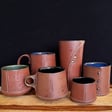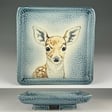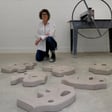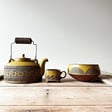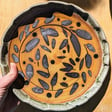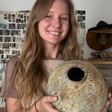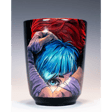The Importance of Initiative
00:00:00
Speaker
And I was the person who was going to make this happen. And if I didn't make it happen, it never was going to happen. Visti, welcome to Champion Pottery and share with me what is something that's helped you the most along your pottery journey so far? There are so many things that have helped, but when you ask the question, the thing that has helped me the most is being surrounded by other potters because we all have a different approach to clay.
00:00:25
Speaker
And even though in my mind, I think that I'm doing the best that I can, I may be missing something that is just tiny that would help me grow in another way. So having people around that are able to help me problem solve or just set a really good example of how to pack up for a show or how to trim a pot, it's priceless. Absolutely great shaping nation. The more you get around other potters or other artists in that matter,
00:00:52
Speaker
the better you're going to learn, even if it's just simply asking somebody on Instagram. I love that.
Discovering Pottery in College
00:00:58
Speaker
So tell me the story how you got started making pottery.
00:01:02
Speaker
I started in clay in college. So I went to Indiana University, Pennsylvania to become an art teacher. And of course, to be a good teacher, you have to learn all the studios. I didn't have any clay experience in high school. So when I got into that clay studio, like many of us, my mind exploded and I never wanted to leave.
00:01:23
Speaker
So that was where that all started really with going to that class and taking it over and over again. I actually dropped other studios so I could take more clay classes. So I probably have a minor in clay as well as my bachelor's degree for teaching. Absolutely love it. What were you feeling during that first clay class?
00:01:44
Speaker
curiosity and just a general happiness of like, what is this stuff? And also being completely amazed by what was going on in that studio. Because even though it was a beginner's class, there were always grad students and upperclassmen in the studio working. So we constantly were being said all of these things that they were making that were, of course, much more advanced than us.
Reigniting Passion at Touchstone Crafts
00:02:10
Speaker
So we could learn by watching them as well as what we were being taught within the curriculum itself. Absolutely love that. So you contribute your growth as an artist to the classes at Touchstone for Crafts. Tell me more about that.
00:02:25
Speaker
So I got my degree in teaching, graduated from college, and then went on to get married and focus on working and having a child. And my life became centered around being an art teacher and setting up adult life. And what I did was I didn't make any art. Like I would make a little bit on the side, but I wasn't taking any classes.
00:02:46
Speaker
And I really needed to take a class because I thought for me to be a teacher, I need to continue growing as well. So I took this class at Touchstone. And it's a week-long immersive class where you stay on campus. They siege you fabulous food. They ring the bell. You go to class. You go to lunch. And you are completely immersed from 9 in the morning until you decide you're going to bed, whether that's midnight or 4 in the morning.
00:03:11
Speaker
And that experience of being around clay people again and having that freedom of just making and not having responsibility, it made my heart explode. And I came home from the class and I met with a friend of mine and I said, I can't live like this anymore because I didn't even realize how much I missed being able to create because I was so focused on being a successful teacher, which is a great thing. But
00:03:37
Speaker
I just forgot that I was an artist and I needed to go back to doing it. So it made me really reevaluate how I was living my life and what needed to change in small ways and then really big ways. So when you were realizing this, well, how did you start bouncing being an art teacher, mom, and also trying to picture your own art?
Balancing Art Teaching and Pottery
00:03:59
Speaker
My leisure time was no longer leisure. And what I started doing was looking for the times that I did have so that I could, I set up a small studio in my garage. You know, I had a wheel, I had a small kiln, and I was able to just decide, okay, I have an hour here. Like, we finished dinner so my son can play with my husband and I can go focus for an hour or I wait till he would go to bed and just do the kinds of things. Because I didn't necessarily
00:04:25
Speaker
bring a lot of schoolwork home with me because I was able to keep work at work and come home and do that. But the biggest thing I did was I gave myself permission to have a babysitter so that I could focus on it. So I didn't watch TV. I stopped watching all the shows that I used to watch because I realized that for me to focus on becoming the potter that I wanted to be, I couldn't do it if I was sitting on my couch. You know, like I was the person who was going to make this happen.
00:04:53
Speaker
And if I didn't make it happen, it never was going to happen. And I was lucky that my family and my extended family were willing to support me and say, yes, we're here for you. We'll take care of him. If you don't show up for that, we get it. So I was really lucky that way. Now, what advice would you give to someone that may be in sort of a similar situation that you were in?
Finding Time for Creativity
00:05:18
Speaker
So nobody's going to do this for you. It hurt. It hurt a lot for me. There was a lot of like hand wringing and crying over like, oh, I feel so badly not doing this and I want to do this. And the people around me said, you, you really need to do this to be happy. So.
00:05:34
Speaker
Take those baby steps. It doesn't have to be giant. It might be that you're going to dedicate yourself to taking a class. And maybe you take it at an art center and it's one night a week, but it is one night a week where you allow yourself to be that artist that you know you are. And that's just the beginning of making time. Or maybe it's an hour in your studio, but no one's going to do it for you.
00:05:56
Speaker
I absolutely love that advice. Shaping Nation, if you're in a situation where you are overwhelmed with work or you are a parent and you want to get in the studio but don't have that time, start with the smallest steps you can make. Get in there five minutes or an hour a day and make time to actually make because that's the most important thing. I love that advice. So now, when you were at Touchstone, what is something you learned that you still use today? Oh, hello.
00:06:23
Speaker
That's a hard one. It was such a magical place. I guess to take advantage of the blocks of time that you have to play and make and do the thing, like take risks and do the things that you haven't done before. Because if you make the thing you already made in the beginning,
00:06:44
Speaker
what you might be perfecting that form, but you're not growing the form. So taking classes like that, the whole point is to learn something new and to absorb what's around you, take that advice that that teacher is sharing. You make the handles that they make because it's how having those skills allows you to grow.
00:07:05
Speaker
So, you know, I still do that. I just took a class with Jen Allen two weeks ago, and I'm still trying to figure out what I learned from that class, but I just sat and absorbed. You know, I was so worried about what am I going to make? I'm like, no, no, no, no. You're not making anything yet. You are just learning, and that's okay.
00:07:22
Speaker
I love that shape nation. You have to change your mindset from being a maker, but you also have to change it to a learning mindset. So let's talk about your pottery. Can you tell me the story, how you started making the pottery that you make today?
Evolving Pottery Style
00:07:37
Speaker
Let's see. So the pottery that I make today comes from my first teacher was a decorator. So in studying his work and watching him work,
00:07:49
Speaker
I learned to take a form and decide where a design would fit.
00:07:56
Speaker
And how does it fit on the whole form? And I know that everybody is influenced by the people that you first lay their eyes on their work. So I had to learn how to find my own patterns and my own design to do those kinds of things. But I think what I learned the most was find a form that I love and then
00:08:21
Speaker
take these ideas that I have for designs and find the best place to fit them on there. Because joining those two loves, like I had a client walk into my booth and an art session and he said, oh, you're a painter. I said, no, I'm a potter. And he said, you're a painter. And I said, oh, I'm a potter who paint. Because I do love that illustrative quality. And that's what I've always worked for is the loose kind of drawing.
00:08:46
Speaker
but incorporating it in all the sweet spots of a pot. So like on a teapot, I will tuck it over to the side, or I'll put it on the top of the lid. And I spend a lot of time just playing around with that. Like, where does it go? Does it fit here or does it fit there? That's probably the first thing that I learned to play around and move those images until they fit where I wanted them to. How can somebody practice that, layering out the images onto the pots?
00:09:16
Speaker
Well, there's two ways that I do them. So when in service meetings or faculty meetings at school, I take my agenda and I just start sketching on the back of it. So I have all these ideas of designs on maybe platters or I'll draw a row of cups and play around with the theme, the same motif. So maybe I want to do, so I will play around with what if I put the blackberries at the top, what if I put them at the bottom and I have all the leaf sketches. Then when I get into the studio and I make my forms,
00:09:46
Speaker
It's a big jump from this flat drawing to wrapping those pieces around a form. And it doesn't always work. But I want it to work, but it doesn't always work. So what I will do is I will sketch out, like for my lemons example, I will sketch out a little group of lemons. If I know that I need two or three of these set, I will cut them out of paper and I will put them on that form. And I will turn it around on the table so I can see, oh, that's too big.
00:10:13
Speaker
That's too small. This needs to be moved right and needs to be moved left. And it helps me play that.
Using Vintage Inspiration
00:10:19
Speaker
I'll even get my phone out and take pictures of it. Like sometimes I'll take pictures of my pots and I'll sketch on them because it's a really big risk to jump into putting images on pots. And I have done that too.
00:10:31
Speaker
I've just thrown all caution to the wind. I've drawn on the pot. Sometimes it works really well. And sometimes I just think you really should have waited. But I have folded little cutouts of leaves. Like sometimes I just need one more leaf. So instead of drawing it on, I will put it on the design and move it to where I need it. And I try my students this at school because they're so afraid to take a risk. So I'll tell them.
00:10:56
Speaker
go draw it cut it out and put it on there and they all of a sudden they're confident like oh i see what you mean this looks so much better this way some excellent advice right there i love that so you are inspired by vintage kitchen towels and aprons how do these things impact the way you make your pottery
00:11:16
Speaker
Well, they're beautiful. They're sweet. They remind me of the women that I grew up with. Like I grew up in my mother's and my grandmother's kitchens. So we, you know, kitchens are full of cooking implements and towels and things. So those aprons that had those kinds of fun
00:11:31
Speaker
illustrations of fruits and vegetables, but those just kind of get stuck on my mind because they're bright and they're colorful. They're very feminine and they just, they kind of found their way to my pots and it became very easy to find, you know, a quick Google search and I was down the rabbit hole and I need to print this one. I need to print this one and I have
00:11:53
Speaker
Dutch books of prints that I cut out and I just have pages and pages of images that if my brain is tired, I will just go browse and look through all of those pictures to see like, oh, I forgot about this lemon and blueberry concrete. What do you mean by when your brain is tired?
00:12:09
Speaker
If I'm trying to come up with a design and nothing's just coming naturally, or I just want something a little bit different and fresh, I might be tired of making the same pattern over and over again. I will go back to these reference books and look for something that's a little bit different that I could incorporate. And maybe it's just a different leaf pattern to change it, or maybe a different grouping of tomatoes. I have a whole book dedicated to tomatoes.
00:12:38
Speaker
How can someone start making their own reference book for themselves?
00:12:43
Speaker
If you spend a little bit of time on Pinterest or anything, start screenshotting images that you like, that you think that you might like that motif on a pot. And if you screensave it, and if you have access to a printer, print it out, and just put it in a notebook. I'm a big fan of, it's kind of a scrapbook sort of thing, and I'll draw around them. And it just makes it really easy.
00:13:13
Speaker
If you really are a digital person, make a folder on your phone and pull those images up. Just have that slide book of things that you are interested in putting it on a pot. And that way your brain is there when it doesn't have an idea. It's a great way to just kind of feed that. I like that. And if you want to use more technology for it, you could even do a slideshow and put it on your computer and just have it be swiping through whatever you're on your computer. You're always having ideas.
00:13:44
Speaker
Absolutely. And then, so something interesting I found is that you make pottery for the daily ritual of eating and drinking. Can you tell me more about this?
00:13:56
Speaker
We are humans are creatures of habit, and we love to give meaning to the things that we do. I think it's just part of our hearts. Not that everything has to have meaning, but we like to give object meaning for the things that we do. So our lives are full of occasion.
00:14:14
Speaker
But I grew up with two families that loved the big table for the big dinner. And one family was very formal. We had the train on, we had the crystal, and we had the good silverware. And then the other family was fit as many people as you can around that table, and every plate in the cabinet has to be on the table.
00:14:35
Speaker
So they were different, but they were the same because we were getting together because we loved each other and there was some kind of a special event going on. So I grew up valuing the dishes and I grew up valuing the meal itself. So that ritual is something special.
00:14:53
Speaker
When I became a potter, I started valuing these beautiful cups. The first cup I ever bought, I just could not wait every morning to have coffee out of this thing. Because it was the first cup that I bought with my own money at a gallery. So it was very, very special to me. And it was Kristin Pavelka, and I bought it at Red Lodge.
00:15:12
Speaker
I'm sorry, I can't think of the name that's out there. It'll come to me later. But it was so special to me that this young artist made this mug that I was immediately drawn to, and I wanted to have that.
00:15:24
Speaker
So having my morning coffee is special because I value this object. I value this art institution who made this thing so that it could be used every day. So I believe we all do that in some way, shape, or form. Anybody listening to this has already thought of the bowl, the cup, and the plate that they use for either every day or like I have cups that are just for tea and I have mugs that are just for coffee. Don't ask me why.
00:15:56
Speaker
It's just funny. I think they taste different that way. But I value that ritual like at home from work. And I have my tea because it's how I can just stop from work, rest a little bit, and then I'm ready for the studio. And that's a ritual and it brings something to my life, my life that this person made this for me to do that. Absolutely. So let's talk about discovering your
Affirmation and Success in Pottery
00:16:20
Speaker
voice. Can you tell me about the moment when you knew you were heading in the right direction with your pottery?
00:16:25
Speaker
I do know an absolute moment, but I know there was a time when I would unload a glaze kiln and everybody knows that's Christmas morning. Open up that kiln and you're peeking in. And as I'm unloading the kiln, I'm smiling. And as I stand back and look at what I've made, I immediately want to go back in the studio and make more.
00:16:49
Speaker
because what I saw was what I felt was successful. So I was really pleased with the work that I had done. It worked well. It didn't craze like the glaze work, the design work, and all of that. And I knew that some people would say, well, that's very egotistical of you. But if that's the whole goal is to be successful, we really should celebrate those times when we feel that we did something very, very well.
00:17:16
Speaker
And then right after that kind of thing was going on in my studio, I was getting feedback from my client who were saying, your work is so happy. I just love having coffee out of your mug. And I just thought, oh, some things are coming together. Not only do I feel good about my work, I mean, I'm invested. So of course, I think that it's really well done. But for my client to really say to me, I value your work.
00:17:44
Speaker
And I love your work. So keep doing what you're doing. That's when I felt like, okay, I'm doing something right. How long do you think it took you to get to that point? Well, probably 10 years. You know, I always liked my work.
00:18:06
Speaker
and felt that I was moving in the right direction. But getting the feedback from the clients is when I really felt like it was super successful. It probably took 10 years, and it took me narrowing down the work that I was doing. I was trying out all kinds of patterns because I was working in underglaze, so it's like the box of thick thousand colors.
00:18:28
Speaker
So I wanted to try all the colors and all the patterns. And I was doing that. And when you walked into my booth, it reflected a lot of beautiful things, but it didn't reflect a singular vision. And once I started moving those other things out and expanding one or two of my designs, that's when it started to evolve. You mentioned narrowing down your work. What did that process look like?
Focusing on Quality and Uniqueness
00:18:57
Speaker
It was hard to decide which ones to go forward with. And at the time, I was fascinated with cherries. So I had this ant who had this cherry tree that was like 40 feet high, and it was those beautiful bright red cherries. And I had to drive my truck underneath it and stand up in there. And I was just surrounded by these beautiful cherries.
00:19:17
Speaker
I had never experienced this before so I was doing these cherry patterns with the terracotta clay with a white background and these bright pops of cherries but also with contrasting black.
00:19:30
Speaker
And people were really responding to that. So I just decided this was the direction I was going to go because the other pieces they weren't responding to. So I was just like, I've got to stop making these because they're filling up my shelves in the back and they're not selling. So I stopped doing those and just focused on the things that I knew.
00:19:49
Speaker
people wanted more of. So they wanted plates to match a mug that they had got. So because I was working within the same color palette and the same pattern, they could get the things that they wanted. And that's how I decided that this was the direction I was going to go in. And I think I ran that one for probably three years. I have a few pieces left now in that bit. I absolutely love that. So what would you say was your biggest obstacle when it came to finding your own book?
00:20:18
Speaker
having too many options. When you have all of the colors and all of the ideas, that's the obstacle because you want to do all the things.
00:20:32
Speaker
just deciding to limit yourself is, it's a decision. And you have to decide, okay, I'm going to stop this thing. And that was difficult for me to do because I was still interested in doing all the other patterns. But in order to really expand this pattern and take it to all the ways that I could, you know, put it on a teapot, put it on all these things and have different versions of it, I really had to focus on doing them. Basically,
00:21:00
Speaker
like creating a shoe brand where you have your style of shoe, but you've got to have 10 to 12 different versions. People have choices. And also, so your brain doesn't die a slow death of doing the same thing over and over again. So how did narrowing down help you expand your voice? It allowed me
00:21:24
Speaker
to go from making just a few things to expanding onto, you know, big oval platters, doing big large decorative vades. Like teapots, there's so many places to decorate on a teapot. You know, I can flip-flop things around and
00:21:42
Speaker
Having a box sometimes is the best thing. By giving yourself limits, it allows you to stay within those limits to expand, which sounds like a really big math problem. If you are able to work with 50 choices, you don't need a thousand because 50 really is enough, or maybe it's four.
00:22:02
Speaker
You know, so limiting yourself just allows you to challenge, you know, challenge the way that you lay things down and move things around. Like I said, with those little pieces of paper, I'm really big about just changing things suddenly or change the background color, and it could change everything.
00:22:19
Speaker
I love that shaping nation. Sometimes the best solution is to literally limit the amount of things you are doing to your pottery, whether the amount of colors you're doing or techniques you're doing or the way you're placing things. Now you're going to get more creative in the way you're thinking. I love that. Now, what advice would you give to someone who will discover their own unique voice with their pottery?
Finding Your Unique Voice in Pottery
00:22:43
Speaker
Give yourself permission to work. You know, as I said earlier, if you don't give yourself time, it's not going to happen. You have to be your biggest advocate within high school. There are so many opportunities for me to do other things.
00:22:58
Speaker
So, I could help coach this, I could do this, you know, like, oh, we need a fundraiser for that, can you sheper in the den? And I had to make that decision of, no, I have a business, and I have a show this weekend, and this is what I choose to do. And what that told my people around me was that my business is important to me.
00:23:21
Speaker
And these other things, it's not that they're not important, but this is the direction that I'm going. So it's almost as if you have to set up boundaries as to what you're willing to do and not do. And it's not, I will do things, but I choose very carefully what it is that I'm willing to give my time to because my
00:23:39
Speaker
My creative life is really important. 24-7, every day of the week is what I do and I wouldn't have it any other way. So if you can give yourself, like we talked about earlier, those baby steps in and those boundaries are valuing your time so that you can put the hours in so that you have time to play with those designs and have time to make more and more and more.
00:24:05
Speaker
How does one create these boundaries for themselves? It's hard because people push back. They really do. And also, too, a lot of the world doesn't value us because we don't put that message out there that our time is valuable.
00:24:23
Speaker
You know, I don't even give reasons anymore. I just say, I'm sorry, I can't do that right now. It's okay. You don't owe the world an excuse. You can't, I have a show and I have to load a kiln, or I can just say I really, I can't do that right now. And sometimes you just have to practice it and take a big deep breath because it is hard to say no to people. It is, and I had to practice it. And sometimes I would say no, and I would have to go into the other room and take a really big deep breath and say, oh my God, I can't believe I said no to that.
00:24:52
Speaker
But I did because every time you do say no, you're saying yes to yourself. And I can't emphasize that enough that you really have to say yes to yourself. I love that shape nation. It's gonna be hard to say no, but you're gonna have to learn to say no, because that's how you continue to grow and you're probably gonna get better. You're gonna be able to make the party that you want to make and have time to.
Joining the Clay Community on Instagram
00:25:15
Speaker
Christy, it's been great chat today. And as we come to a close here, what is one thing when I hammer home with my listeners today?
00:25:22
Speaker
Get in your studio. You've got to get in your studio and work and take the risk. Make the pot. Make more pot. Now you just got to make and sign friends. Sign really good friends. Absolutely agree. Some excellent parting words of advice. Christy, it's been a great chat today. Where can my listeners go and learn more about you? Uh, on my Facebook page, it's Christy Culp's mix. Um, I post things there. Instagram's the better place to get me. I tend to post there more.
00:25:49
Speaker
Um, you can get a hold of me there to hit me up on messenger. I love hearing from people. You know, I love connecting with more clay people. Hey, thanks for listening to this episode of Shaping Your Pottery with Nick Torres. If you enjoyed this episode, come join the Shaping Your Pottery newsletter, where I go into behind the scenes looks of how potters make their pottery and give you tips on how to grow your pottery and find your voice as well. If you want to join the Shaping Your Pottery newsletter, go to shapingyourpottery.com for the newsletter or click the link in the description to sign up.


